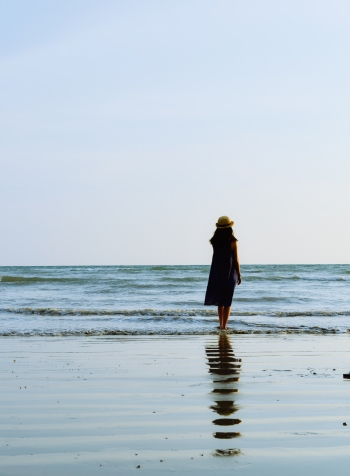
Got That Summertime Sadness?
About a month is left of Summer, and the end of the season can't come soon enough. The smell of charcoal from sizzling grills continue to fill the air, your friends are inviting you to the beach, and you want to hide in your room. The sun feels like a burden, the heat feels draining, and the fear of what you're missing out on only makes you feel worse. If this sounds like you, you may have Summertime sadness. No, not the kind you may have heard playing on the radio, but something called Seasonal Affective Disorder.
Seasonal Affective Disorder, or SAD, is a type of depression that affects folks seasonally. You may have heard of SAD, and you may understand it as affecting people mostly in the Fall and Winter months. So why do you feel like you're sitting on the sidelines of what many people consider the best time of the year? You may be surprised to know...
It's Okay to Feel Sad in the Summer
Yes, you heard it right! It's okay to feel sad in the Summer, in the Spring, or any other time of the year that you do. People with SAD can feel depressive symptoms in both the Winter and Summer months. For those who only experience seasonal affective disorder in the Summer, it is known as summer-SAD (S-SAD), which involves recurrent depressive episodes that occur in Spring or Summer, and fade once the Fall and Winter come in. It can be easier to conceal or push away sad feelings when the weather is cold; during the Winter months you are kind of in hibernation after all. A lot of people are, so you don't experience some of the things that may cause S-SAD.
For example, you may not feel the obligation to attend every BBQ your aunt throws and watch your family members argue over politics in the Winter. You may be less likely inclined to bump into that ex walking down the street in your neighborhood if it's cold out. Seeing more people you usually might not see can absolutely contribute to how you feel. When people are more likely to be out and about, the chances go up of seeing or interacting with people that may trigger unwanted thoughts or feelings. If you're learning how to be comfortable in your skin, sometimes Summer can feel like an involuntary push into the realm of shorts and tank tops you're not ready for. For those with children, the extra time with your kids may test the limits of your sanity. Also, all those fun activities people keep inviting you to can end up costing quite a bit of money. If you are experiencing financial hardship, this can make you feel left out or shameful of your finances. S-SAD can even occur for folks who work seasonally, the lack of structure may increase feelings of stress and anxiety. If you identify with any of these, you're not alone. About 10% of the population will experience symptoms during the warmer seasons.
While there are several reasons why you may have S-SAD on an emotional level, environmental and physiological factors can play into it, too. For example, studies have shown that moods can worsen on days where there is a combination of high temperatures, humidity, and high pollen. High temperatures and humidity in the Summer months can affect you physically by increasing your heart rate, making you extra thirsty, and causing electrolyte imbalances. For those with allergies, your immune response to higher than usual levels of pollen may increase your odds of S-SAD. Additionally, what part of the world you live in can have an effect on your feelings. Researchers found that for those living in the United States, SAD is experienced more often when the days are shorter. For those living in places like the Philippines or China, where there are generally longer days, folks have reported feeling worse during days with longer photoperiods.
I Don't Want to Go Outside!
If you're experiencing symptoms of sadness, fatigue, pessimism, irritability, and you suspect you may have summer seasonal affective disorder, then give yourself permission to stay inside and take care of yourself on the days you are not obligated to venture out. If you are going to stay inside, try making your space one that is inviting, clean, and comfortable.
Keeping It Comfortable
The environment we live in can influence our mind. If you are depressed, cleaning your space may not feel intuitive, but it can clear your mind and boost positive feelings. Try focusing on one task, such as putting away your clothes or washing your dishes (or a few dishes!), and if you want to keep going, go for it. If there is a lot of clutter around you, try using the "five second rule" to determine what to do with items taking up space. This widely adaptable "five second rule" looks like this: pick up an item and within five seconds, determine if you need it. Countdown out loud or in your head from five. Commit to keeping the item and putting it away, or donating it. Ask yourself questions like, "Does this serve a purpose in my home?" or "Is this item irreplaceable?" Many of the items you pick up will elicit a quick response - yes, I would like to keep this spatula, thank you very much - but for others, give the five second rule a try.
This can also be a good time to add small touches to your space that will make it cozy and comfortable. If you feel inspired this can look like rearranging the furniture in your room, but can also look like adding texture to your space in the form of pillows and artwork. Even the colors around you can factor into your mood. Think about the colors that make you feel good and try to incorporate them into your space. Warm colors such as red, yellow, and orange can stimulate energy and feelings of happiness, while blues, greens, and purples are more soothing.
Let Light In
For those who experience SAD in the Winter months, light therapy can prove a valuable treatment option and is commonly used to help treat seasonal affective disorder. Light treatment therapy can look like a SAD lamp, or a lamp that emits bright white light. It can be used for S-SAD as well. If you are inside, try letting some light in by opening your curtains. Once your curtains are open, try sitting under or near the light for at least thirty minutes. Even turning on the light in your space can help, so flip the switch. It can feel counterintuitive to let light in when you want to curl up in the dark of your room, but research has shown reduced sunlight can decrease your serotonin levels. Serotonin, your body's "feel good" chemical, helps you to feel more focused, emotionally stable, and calm.
You’re Not Alone
Even if you choose to stay inside, try to stay connected. If a beach day with friends isn’t on your radar, work collaboratively with your friends or family to find a way that feels doable for you. This could look like inviting your friends over to your home, seeing a movie at a theater (by yourself or with a friend…this still counts!), or setting up the time to connect online. For folks who are interested in making new social connections, consider joining an online community pertinent to your interests, or try a new activity like an online drawing class.
When you’re feeling depressed, it can feel like you don’t want to be around others at all. However, social isolation and loneliness are known to make depressive symptoms worse.
It’s okay to talk to people you trust about your feelings; in fact, it may be helpful to let your friends and family know you’re just not feeling it. It’s also important to recognize when you could use the extra support.
Talk It Out
The reality is that depression affects everyone differently and is indiscriminate over the time of year it affects you. Talking to someone may help sort out what is contributing to your S-SAD and support you while you work through it. When you're talking to a therapist trained in CBT, or cognitive behavioral therapy, they can help you identify and challenge some of the thoughts contributing to your sadness, and with your help, challenge them. Talking to someone can help you realize and gain control over the thoughts and feelings keeping you from attending that outdoor concert with your friend, or keeping you content during a cozy night in with your favorite film. If you’re concerned about making your appointment, sessions can even be held virtually. If you'd like to talk to a therapist, you can call (215) 922-LOVE (5683) ext 100 to be connected with the intake department at The Center for Growth, where therapists trained in CBT are ready to work through your S-SAD.












